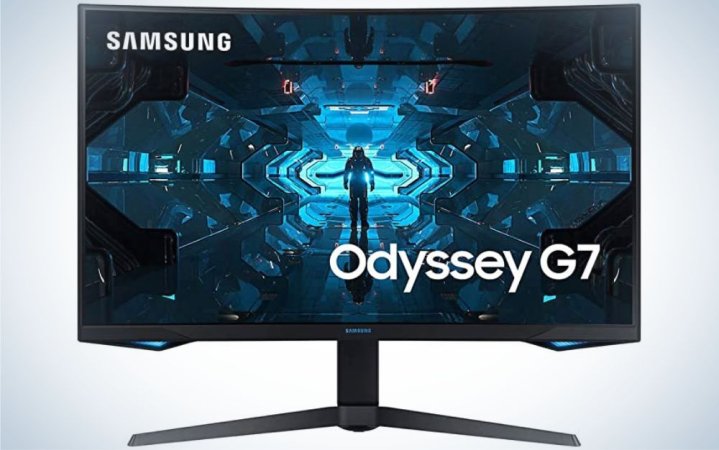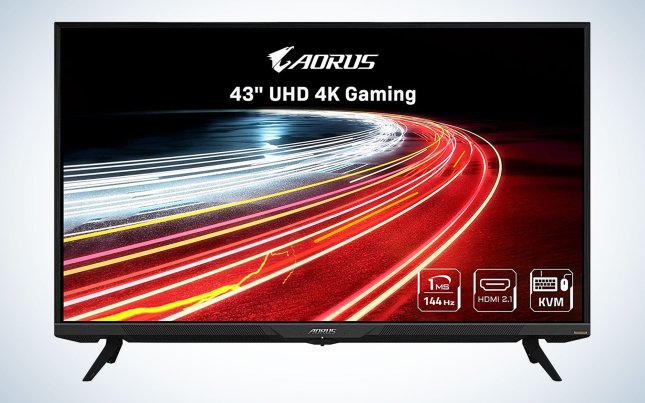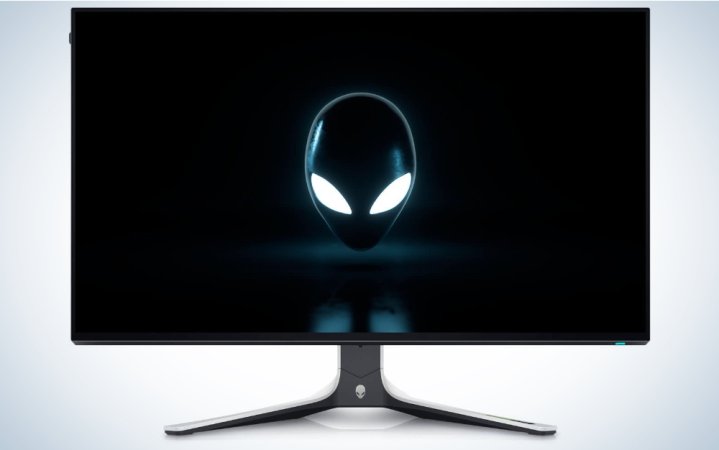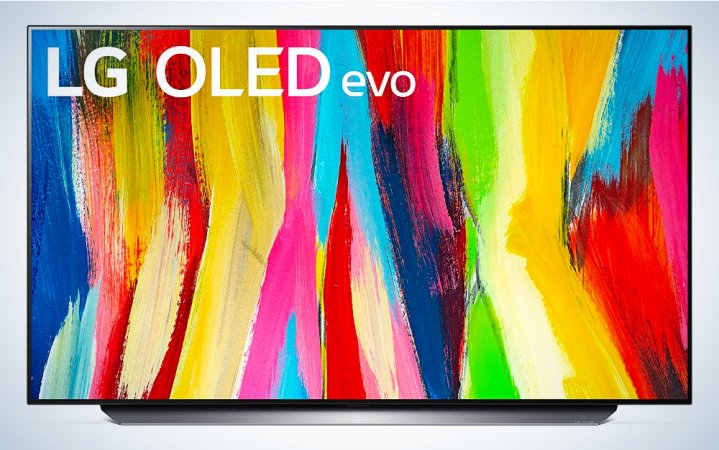We may earn revenue from the products available on this page and participate in affiliate programs. Learn more ›

The Xbox Series X will allow you to fully appreciate one of the most powerful home consoles of all time, assuming you have a monitor that does its games justice. With Xbox Game Pass, the Netflix-style game library subscription, expanding all the time, now is the perfect time to grab Microsoft’s newest 4K-capable game console. It plays both Xbox Series and Xbox One games in 4K at a rock-solid 60 frames per second, with some games already running at 120fps. Microsoft also promises 8K capability is on the way once a critical mass of content and screens rise to the challenge. While we generally associate console games with flatscreen TVs, many players prefer the expanded configuration options of traditional PC monitors, even for console gaming. To get the most out of the Xbox Series X, however, requires a fairly high-end gaming monitor. We’ve rounded up the best monitors for Xbox Series X to help you find the right panel to unlock all of its power.
- Best overall: Philips Momentum 559M1RYV
- Best 1440p 144Hz monitor: Alienware AW2723DF
- Best 4K gaming monitor: ASUS TUF Gaming VG289Q
- Best TV: LG C2 OLED
- Best curved: Samsung Odyssey G7
- Best budget Gigabyte AORUS FV43U
How we chose the best monitors for Xbox Series X
Through testing, reading monitor reviews, and a lifetime of experience in both console and PC gaming, we surveyed modern monitors on the market right now and drilled down on those capable of showcasing the Xbox Series X’s graphical specs. We selected monitors that are all well-reviewed and offer solid value for their price, including both overall top choices as well as products that selectively cut corners to reduce cost, with options that preserve resolution and frame rate.
The best monitors for Xbox Series X: Reviews & Recommendations
True to Microsoft’s PC roots, the Series X offers a more generous range of monitor compatibility than any other console on the market. That means the “best” monitor for you depends entirely on your priorities. No matter your budget or interests, we’re confident that you’ll be able to find a great fit among our selection below to really make the best Xbox Series X games pop.
Best overall: Philips Momentum 559M1RYV
The Extra Large Xbox Monitor
Pros
- 4K/144Hz
- HDMI 2.1
- TV-sized 55-inch panel
- Built-in soundbar
Cons
- Expensive
Why it made the cut: The Philips Momentum is a huge, fast display optimized for the Xbox Series X, with a high-quality built-in sound system for good measure.
Specs
- Resolution: 4K (3840 x 2160)
- Refresh Rate: 144Hz
- Size: 55 inches
- Ports: HDMI 2.1 (3) DisplayPort 1.4, USB-C (1), USB-B (1), USB 3.2 (4)
- Panel Type: VA
- HDR: DisplayHDR 1000
Philips made one of the first “Designed for Xbox”-certified monitors for the Xbox Series X, and it’s a doozy. At 55 inches, the Phillips Momentum looks more like a television but has all the fine-grained control and port options you would expect from a dedicated gaming monitor. It hits all of the console’s top specs with 4K, 144Hz, HDMI 2.1, and HDR. It also includes a fantastic built-in 2.1-channel stereo Bowers & Wilkins soundbar, as well as Ambiglow lights on the back that can be programmed to match your content. VA (Vertical Alignment)-type panels, compared to IPS (In-Plane Switching) ones, historically sacrifice a bit of speed in order to get rich colors and contrast, but the Momentum has been built from the ground up for gaming and, as our reviewer discovered, excels even when your game moves at top speed.
Best 1440p 144Hz monitor: Alienware AW2723DF
Best G-Sync 1440p 144Hz monitor
Extremely Fast and Exceptionally Smooth
Pros
- Up to 240Hz refresh rate
- DisplayHDR 600 certified
- 32 local dimming zones
- Excellent color coverage
Cons
- Screen glow can be an issue
- 1ms response time only possible in “Extreme Overdrive” mode
Why it made the cut: The Alienware AW2723DF is an outstanding monitor for Xbox gaming.
Specs
- Resolution: 1440p (2560×1440)
- Refresh Rate: 144Hz
- Screen size: 27 inches
- Ports: HDMI 2.0 (2) DisplayPort 1.4 (1), USB-A (4), USB-B (1)
- Panel type: IPS Nano
- HDR: VESA DisplayHDR 600
The Alienware AW2723DF was designed with PC gamers in mind—which is why it made the cut in our guide to the best 1440p 144Hz monitors—but Xbox Series X owners will be able to take advantage of most of the same features. This includes its ultra-high refresh rate (the Xbox Series X only supports up to 120Hz gameplay), and support for VESA DisplayHDR 600. Many cutting-edge Xbox Series X games support HDR (high dynamic range) for better color reproduction, so having it here is a big deal. For non-HDR games, the AW2723DF’s support of 95% of the DCI-P3 color spectrum will keep them looking punchy as well.
One of the display technologies Alienware opted to support with the AW2723DF is local dimming zones, which are primarily found on TVs. This allows the monitor to adjust the brightness in 32 different sections of its display independently, which significantly improves contrast. Here’s an example: If you’re playing a game in which you’re traversing a dark cave with a torch, the monitor won’t have to brighten the entire screen for the sake of making the torch easier to see. You’ll get the dankness of the cave all around you, with only the sections of this monitor illuminated by the torch looking brighter. The effect is more realistic-looking environments.
Finally, if you’re a cross-platform gamer—a person who likes to play games on multiple systems—the AW2723DF’s bevy of ports will come in handy. You can hook up two consoles and a PC to the display simultaneously—no need for an HDMI switch or constantly shuffling cables.
Best 4K gaming monitor: ASUS TUF Gaming VG289Q
A Little 4K… As a Treat
Pros
- 4K
- Great value
Cons
- Middling HDR
Why it made the cut: The ASUS TUF Gaming VG289Q is a great entry-level 4K monitor that strikes a balance between quality and cost.
Specs
- Resolution: 4K (3840 x 2160p)
- Refresh Rate: 60Hz
- Size: 28 inches
- Ports: HDMI 2.0 (2) DisplayPort 1.2
- Panel Type: IPS
- HDR: HDR10
Playing games running at 120fps sounds exciting on paper, but realistically, you’re looking at diminishing returns at higher and higher frame rates. The debate is still open on the ceiling for what the human eye can perceive. However, 60fps is the current gold standard for silky smooth precision gaming and will be more than enough for all but the most hardcore competitive gamers looking to eke out every possible marginal advantage. The ASUS TUF Gaming VG289Q delivers excellent, color-accurate 4K graphics at a steady and still-reasonable 60Hz. While less than perfect for the Series X on paper, many games still run at 60fps in 4K, making this a perfectly reasonable compromise.
Best TV: LG C2 evo OLED
Sometimes The Best Monitor is Actually a Television
Pros
- 120Hz on a TV
- HDMI 2.1
- Incredible blacks and color range
- Wide viewing angles
Cons
- Very expensive compared to monitors
- Burn-in risk
Why it made the cut: If cost is not a concern, LG’s OLED TVs are the gold standard for incredible image quality with no compromise in responsiveness.
Specs
- Resolution: 4K (3840 x 2160p)
- Refresh Rate: 120Hz
- Size: 48 inches
- Ports: HDMI 2.1 (4), USB 2.0 (3)
- Panel Type: OLED
- HDR: Yes
All of the monitors on our list feature LCD technology, which requires a backlight, but the next generation of screens is starting to shift over to new display technology. An organic light-emitting diode, or OLED, display lights each pixel independently, allowing for brighter colors and rich, perfect blacks. If you want an OLED display right now, you need a TV, not a monitor.
LG’s C2 OLED is realistically the best TV for gaming right now. It features all of the top specs you need to get the most out of the Series X, including 4K resolution, a 120Hz refresh rate, and HDMI 2.1 ports so you can achieve those specs. Our top monitor, the Phillips Momentum, is just as big as a TV. The LG C2 is sort of the opposite side of the same coin: a TV with many of the technical advantages you’d find in an Xbox-friendly monitor.
Best curved: Samsung Odyssey G7
Best overall
Best Bang For Your Buck

Pros
- Deep, immersive curve
- Crisp 1440p resolution
- An esports-grade 240Hz refresh rate
- QLED panel ensures high brightness and contrast
Cons
- Curved monitors reflect more light
Why it made the cut: The Samsung Odyssey G7 delivers a great picture and outstanding value.
Specs
- Resolution: 1440p (2560×1440)
- Refresh rate: 240Hz
- Screen size: 27-inch
- Ports: HDMI 2.0(1), DisplayPort 1.4 (2), USB-A (3), USB-B (1)
- Panel type: QLED
- HDR: Yes
Curved monitors aren’t exactly mainstream, but they’re gaining in popularity thanks to their ability to offer a unique experience—ultrawide models are especially for gaming. The Samsung Odyssey 7 is a 1440p 27-inch display with a 240Hz maximum refresh rate, HDR support, and an HDMI 2.1 port. The Xbox Series X can take advantage of all these features. The main reason to consider the Odyssey G7 is its curve, which allows the screen to take up more of your peripheral vision. A curved display will reflect more light, so you should think twice about picking this display up if you game in a room that gets a lot of sun.
Samsung’s decision to build the Odyssey 7 with a QLED panel and HDR ensures you’ll get more realistic colors in games designed with high dynamic range in mind. Another core strength of this monitor is its wide array of ports. This will typically only benefit folks who use this monitor with a PC and one console, but it’s something to keep in mind. The ability to use the Odyssey G7 as a USB hub in addition to a display shouldn’t be discounted. We selected this display as the best curved monitor of 2023 and feel it’s an excellent choice for Xbox gamers who’d like to give this type of screen a shot.
There are bigger, brighter monitors on the market, including several from Samsung: the 32-inch Odyssey G7 Neo, which offers an incredible 2000 nits of peak brightness, the 4K-enabled 16:9 Samsung Odyssey G8, and, if you have a gaming desk with space for an ultrawide display, the luxury Samsung Odyssey OLED G8. You can really level up that battlestation with this 34-inch 21:9 Ultra-WQHD screen supporting 0.03ms response times, 175Hz, FreeSync VRR support with G-SYNC compatibility, and DisplayHDR True Black 400 levels. The Neo G8 has more resolution (good for streaming content) and a higher refresh rate/lower lag for competitive gaming. In a dark environment, however, the OLED G8 offers amazing contrast with impossibly inky blacks and smoother motion handling, making it both perfect for productivity and very console-friendly.
Those are notable upgrades but come with much steeper price tags ($1,000 on average). For many players, the $500 QLED Odyssey G7 is more than enough to achieve peak performance without overspending.
Best budget: Gigabyte AORUS FV43U
Smaller, But Still Epic
Pros
- 4K/144Hz
- HDMI 2.1
- Great HDR and accurate color
- Low price for the spec and size
Cons
- Narrow viewing angles
- Fixed stand
Why it made the cut: The Gigabyte Aorus FV43U hits all the same performance benchmarks as our top choice, but for substantially less money.
Specs
- Resolution: 4K (3840 x 2160p)
- Refresh Rate: 144Hz
- Size: 43 inches
- Ports: HDMI 2.1 (2) DisplayPort 1.4 (1), USB-C (1)
- Panel Type: VA
- HDR: DisplayHDR 1000
The Gigabyte Aorus FV43U is an incredible deal among the small number of HDMI 2.1-compatible monitors available right now. Like our top choice, it has a 144Hz refresh rate, 4K resolution, and a VA panel with fantastic contrast and color gamut, making them functionally equivalent in many situations. At 43 inches, it also sits squarely between monitor- and TV-sized displays, which is great if you want a big screen but may be a problem if you want to adjust your monitor’s viewing angle the way you would with a standard PC monitor. User reviews also suggest that its colors get a little washed out as you move away from the center. That said, those are relatively wonky caveats on a monitor that costs hundreds of dollars less than our top pick.
What to consider when buying the best monitors for Xbox Series X
Microsoft’s long history with PCs and PC gaming means that the Xbox Series X is probably better equipped to work with most gaming monitors than any other console, past or present. While most monitors will technically work with the Series X, not all can support its full capabilities. Microsoft has helpfully added monitors to its Designed for Xbox hardware partnership program, which highlights gear that’s fully certified to work with it, but that only covers a tiny fraction of the compatible monitors available on the market. Premium graphics tend to come at a premium price, so if you can’t shell out more than the cost of the console itself for a top-tier display, you should primarily decide whether you care more about resolution or frame rate, which broadly map onto whether you care more about sharper visuals or smoother gameplay.
What is HDMI 2.1?
As many of the best gaming monitors can attest, the PC gaming community continues to shift toward DisplayPort cables for your monitor connectivity needs. It’s worth noting because the Xbox Series X (and PlayStation 5) ideally call for HDMI 2.1, the latest iteration of the ubiquitous HDMI cable.
Despite the fact that the connectors look the same as older iterations of HDMI, HDMI 2.1 greatly increases how much data moves from computer to screen. HDMI 2.0 offers a maximum data transmission rate of 18 gigabits per second, allowing you to output video and games in 4K resolution at 60Hz, or in 1080p resolution at up to 240Hz. With HDMI 2.1, the maximum jumps up to 48 Gbp/s, allowing computers—including game consoles—to play 4K video at up to 180Hz, or in 8K at 50Hz.
For the Xbox Series X in particular, HDMI 2.1 gives you the chance to play games in 4K resolution at up to 120fps. Not every new game supports that high spec, but a growing list of modern Xbox games can make it happen. The Series X and all of these monitors are also compatible with older HDMI monitors and cables, but the display won’t be able to show games running above 60fps in 4K.
While Microsoft claims the Xbox Series X hardware can handle 8K gameplay, the console doesn’t support 8K gameplay. Microsoft has promised to unlock 8K in the indeterminate future, which will require a frame rate trade-off even with HDMI 2.1.
Aspect ratio and resolution
Speaking of 4K and 8K, let’s talk about the size and shape of your monitor. Generally speaking, we recommend picking a monitor’s size based on the resolution you plan to use for your games. Since the Xbox Series X outputs at 4K resolution, you’re ideally going to get a big monitor: 32 inches or more.
Resolution refers to the number of pixels on screen, with higher resolutions being capable of more fine-grained detail and smoothness. Unlike the limited monitor resolution options on the PlayStation 5, Xbox Series X supports an impressively wide range of resolutions: Standard HD (1280 x 720 pixels), (confusingly also named) Standard HD (1920 x 1080 pixels), Quad HD (2560 × 1440 pixels), and Ultra HD/4K (3840 x 2160 pixels).
Unlike with TVs, 4K is not ubiquitous on PC monitors. In fact, a large 4K monitor will be quite expensive. If resolution isn’t your top priority, sacrificing 4K and going with a 1440p/144Hz monitor for the best possible performance without sinking a ton of money into your new display.
If you’re planning to buy a monitor for playing console games, you should stick to a conventional aspect ratio. Aspect ratio refers to the proportion between length and width of the screen, defining standard shapes at which content can be created and scaled. The Xbox Series X only outputs at 16:6 “widescreen,” the most common aspect ratio used in contemporary screens. Although curved 21:9 “ultrawide” monitors are a growing niche among enthusiast PC gamers, it’s still too small a niche to merit Microsoft’s support yet.
Refresh rate, response time, and input lag
When judging how smoothly a game animates, frame rate is king. Refresh rate, measured in hertz (Hz), determines the highest possible frame rate at which a game “runs.” More precisely, it refers to the number of times per second a monitor can “draw” an image on your screen. Even if a console is powerful enough for a game to run at 120 frames per second and the game supports that spec, you won’t be able to see it unless the monitor can refresh at that speed.
Frame rate rarely matters for TV and film, which are still traditionally filmed at 24fps, but frame rate matters quite a bit in games, which is why TV manufacturers have started to make more high-frame-rate TVs in 2023. In a video game, more frames translate into smoother animation and, often, more information. Being able to more quickly and subtly perceive motion can give you an edge in action-oriented games, especially when playing against other people online. During the PS4 and Xbox One era, frame rates between 30fps and 60fps were the standard. The PS5 and Xbox Series X have now raised the bar to between 60fps and 120fps.
Thus, in order to get the most out of your console, you’re going to want a monitor with a max refresh rate of 120Hz or higher. As with resolution, there are other options available aimed at PC players. You can find monitors that go up to 240Hz or even an absurd 360Hz, which really pushes the border of what the human eye can perceive. The Xbox Series X caps the frame rate at 120fps, though, so don’t pay for frames you don’t need. The most common refresh rate to meet the 120fps standard is 144Hz, so that’s what you’re looking for.
Variable refresh rate
Variable refresh rate has become a major technology for gaming displays, allowing the monitor to smoothly ramp the frame rate up and down to match computational performance. It allows for consistently crisp graphics and fewer visual artifacts, especially when there is a lot of fast motion, which happens a lot in video games. The two primary graphics card manufacturers, Nvidia and AMD, both have their own versions of variable refresh rate technology: Nvidia G-Sync and AMD FreeSync. The Xbox Series X support FreeSync, so you want to keep an eye out for FreeSync monitors and, in many cases, avoid G-Sync monitors, as they tend to be more expensive.
What about HDR?
The Xbox Series X also supports one of the latest in-vogue display technologies: High Dynamic Range, or HDR. HDR creates a wider range of in-game darkness and light on 4K monitors with high brightness and color contrast. HDR monitors are brighter overall, with richer, more accurate colors and more nuance in both shadows and bright areas, making images pop more overall.
To create that enhanced brightness, you need a very bright display—so HDR can be a strength or a weakness for any modern display. Some monitors technically feature HDR support but lack the maximum brightness to create a true range of lighting conditions. When considering a monitor’s HDR, you want to check its brightness settings: Look for a maximum brightness of at least 500 to 600 nits, ideally with a feature called full-array local dimming, which determines how much the monitor can change the brightness of specific parts of the screen.
In addition to supporting HDR10—the most common, open standard that PC monitors use almost exclusively—the Xbox Series X is also the first console to support Dolby Vision, which is a proprietary alternative HDR standard that’s slightly better than HDR10 by virtue of being “dynamic” (basically including more data by tweaking brightness and contrast frame by frame). For now, this only really applies to televisions, however, as Dolby Vision is extremely rare among monitors, and those that do are geared toward photo and video work, not gaming.
FAQs
The Xbox Series X supports a wider range of monitor specs than any other console, current or previous, with 1080p, 1440p, 4K+, and 30fps to 120fps. That means the cost varies quite a bit as well. Our list spans from around $1,500 at the high end to $300 at the budget end, but you could go even lower still, closer to $200 if you wanted a still-solid 1080p high-frame-rate monitor.
Yes, the way good HDR makes visuals really pop is just as applicable to games as it is to movies and television. The Series X is also arguably the most HDR-friendly console to date, with automatic calibration, retroactive addition to backward-compatible titles, console-first Dolby Vision compatibility.
“Better” is really a matter of taste, but the advantages people associate with curved monitors—reduced eye strain, more integrated peripheral vision, enhanced “immersion”—all map well to the priorities of gaming. That said, the Xbox Series X does not support any aspect ratio wider than 16:9, so players will not be able to really use a curved monitor as intended. As such, we do not recommend buying a curved monitor to use with an Xbox Series X (or any console, for that matter).
Yes. The Xbox Series X is able to play some games at a native resolution of 4K. Titles that support that resolution will look far sharper than they would at full HD (1080P). The extra resolution won’t hurt if you use the monitor with your computer for work, as it’ll give you a larger digital workspace to work with.
No. The Xbox Series X tops out at 120Hz.
No. Many gamers play Xbox Series X games on a television as large as 65 inches (sometimes more). Most computer monitors aren’t that large, but a 32-inch monitor will provide a better gaming experience than smaller ones if they both have the same technical specs.
Final thoughts on the best monitors for Xbox Series X
- Best overall: Philips Momentum 559M1RYV
- Best 1440p 144Hz monitor: Alienware AW2723DF
- Best 4K gaming monitor: ASUS TUF Gaming VG289Q
- Best TV: LG C2 OLED
- Best curved: Samsung Odyssey G7
- Best budget Gigabyte AORUS FV43U
Chip shortages once meant that the Xbox Series X, like the PS5, was a precious commodity more than a year into its lifecycle. The global supply chain finally stabilized, and now the world is next-gen gaming to its heart’s content, so it would be a real waste not to have a display that is up to the task. Fortunately, Microsoft supports a generous range of display specifications on the Series X, so once you’ve sorted out your budget and priorities, the perfect monitor is just out there waiting for you.








